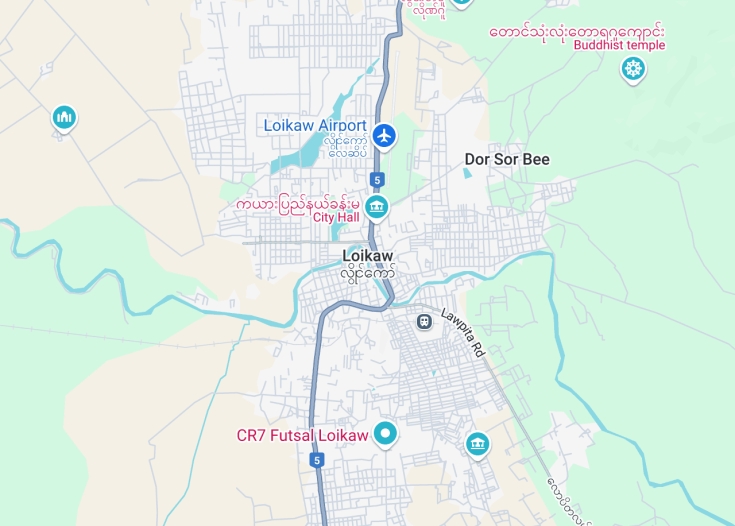Loikaw, the charming capital of Kayah State in Myanmar, offers a unique blend of cultural heritage and natural beauty. This serene destination is renowned for its scenic landscapes dominated by the famous Taung Kwe Pagoda, dramatically perched on limestone outcrops. Ideal for explorers and culture enthusiasts alike, Loikaw’s traditional villages, bustling markets, and tranquil rivers set a picturesque scene for an authentic Burmese adventure. Engage with the friendly local communities, and discover intricate handicrafts and the rich history that shapes this captivating area.
Ensure to visit during the cooler months from November to February for a comfortable experience exploring Loikaw’s outdoor attractions.
Consider hiring a local guide to gain deeper insights into the cultural significance of the sites you visit and enhance your overall experience.
Top things to do & see in Loikaw
Select the following sights and activities to discover best tickets and tours available in Loikaw.
Loikaw: A Hidden Gem in Myanmar
| Country | Myy |
| Time in Loikaw | GMT+6:30 |
| Language spoken | Burmese |
| Population | 17,000 (2021 Census) |
| Currency | Burmese Kyat (MMK, K) |
| Airports |
|
Loikaw, the capital of Kayah State in Myanmar, is steeped in a blend of natural beauty and cultural heritage. Surrounded by picturesque landscapes, this small town offers a charming escape with its rich ethnic diversity, primarily the Kayah people, whose traditions and festivities provide a unique cultural experience for visitors. Moreover, the town is famed for nearby natural sites like the Seven Lakes and Taung Kwe Pagoda, built atop a striking limestone outcrop, which offers panoramic views of the surrounding area.
Where is LLoikaw?
Loikaw is located in the eastern part of Myanmar, nestled among the expansive mountains of Kayah State.
Distances:
| Route | Distance by car | Time by car |
|---|---|---|
| Yangon to Loikaw | 500 km | 16 hours |
| Mandalay to Loikaw | 400 km | 12 hours |
What is Loikaw famous for?
Loikaw is renowned for its ethnic diversity, vibrant local markets, and traditional long-necked Kayan women. It serves as a gateway to the rarely visited Kayah villages, offering a glimpse into the authentic indigenous culture and traditions.
History
Pre-History to Early Dynasties
Archaeological evidence suggests that the area surrounding Loikaw has been inhabited since prehistoric times. The fertile lands and abundant water sources made it a favorable spot for early human settlement. The earliest known communities were primarily agrarian tribes, thriving on agriculture and livestock farming. As these communities grew, a structured form of governance began to take shape, and by the 9th century, Loikaw was a burgeoning village under the influence of larger Burmese kingdoms.
9th Century-19th Century
From the 9th century onward, Loikaw came under the sway of the Pagan Empire, contributing to the spread of Theravada Buddhism in the region. Temples and pagodas constructed during this period laid the foundational cultural heritage of Loikaw. After the fall of Pagan in the 13th century, the region experienced several shifts in control among local warlords and transient kingdoms until the 19th century when the British Empire took control, marking the beginning of the colonial era in Burma.
20th Century to Present
The 20th century was a period of significant upheaval for Loikaw like much of Myanmar. After achieving independence from British rule in 1948, Loikaw, situated in the newly established Kayah State, witnessed ethnic and political conflicts. These conflicts influenced much of its modern history, restricting development and affecting the local population. In recent years, however, Loikaw has begun experiencing growth in tourism, which has aided in its economic development, introducing new opportunities and challenges for the local communities. Sustainable tourism has become a focal point, aiming to preserve the unique cultural heritage while promoting economic benefits.
Visit Loikaw
What to see and do in Loikaw, Myanmar
Exploring Loikaw offers a rich immersion into the cultural heritage and natural beauty of Myanmar. Visitors can tour the iconic Taung Kwe Pagoda, perched atop a hill and offering panoramic views of the city. Nature enthusiasts will enjoy a trek to the nearby waterfalls and the serene Inle Lake. The local markets present an opportunity to engage with the vibrant local culture and cuisine. Historical enthusiasts can delve into the ethnic museums showcasing traditional crafts and customs.
Festivals and Celebrations in Loikaw
Loikaw is renowned for its vibrant festivals, particularly the Kay Htoe Boe Festival, which is unique to the Kayah state and occurs in March. This colorful event features traditional attire, music, and dance, celebrating the local culture and heritage. Another significant event is the Kayah State Day in January, marking the state’s history and achievements with various cultural exhibitions and activities.
Best time to visit Loikaw
The ideal time to visit Loikaw is during the dry season, from November to February, when the weather is cooler and more conducive to outdoor activities. This period also aligns with major local festivals, providing an enriching cultural experience.
Is Loikaw worth visiting?
Loikaw provides a compelling destination for those interested in exploring a less-traveled part of Myanmar. The city offers a blend of natural beauty, cultural richness, and historical significance. However, visitors may face challenges such as limited transportation options and relatively undeveloped tourist infrastructure. Despite these hurdles, the genuine hospitality of the local people and the serene, untouched landscapes make Loikaw a worthwhile addition to any travel itinerary, particularly for those seeking an authentic cultural experience away from mainstream tourist spots.










